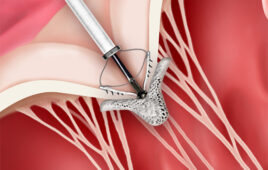CardioKinetix Inc., a medical device company pioneering a catheter-based treatment for heart failure, today announced the transmission of a live satellite feed of a clinical case using the first-of-its-kind catheter-based Parachute ® Device at the annual 2013 EuroPCR Conference in Paris.
The Parachute procedure was performed by Dr. Martyn Thomas, M.D., chairman of Cardiology at St. Thomas’ Hospital in London, England, with assistance from Dr. Hüseyin Ince, Prof. of Medicine, University Hospital Rostock, Germany.
“Patients with ischemic heart failure have few effective options for their debilitating condition,” said Dr. Thomas. “I am always excited to perform the Parachute procedure, and give another patient hope for a better life. The procedure today went smoothly.” “We are thrilled with the growing level of interest in the Parachute device demonstrated at EuroPCR this year,” said Maria Sainz, president and CEO of CardioKinetix. “Over and over again, we are hearing about the need for new therapies for heart attack survivors who develop heart failure over time. We believe that the Parachute addresses this unmet need with a technology that not only improves lives but could also reduce healthcare spending in the treatment of patients with heart failure.” After a heart attack, many patients experience enlargement of their left ventricle causing a decrease in cardiac output resulting in heart failure symptoms such as shortness of breath. Treatment options for patients whose ventricle has enlarged are limited. The Parachute device offers the first minimally invasive catheter-based treatment to partition the damaged muscle, excluding the non-functional heart segment from the healthy, functional segment to decrease the overall volume of the left ventricle and restore its geometry and function.
About Heart Failure
Heart failure is a common, debilitating, and potentially deadly condition in which the heart is unable to supply sufficient blood flow to meet the needs of the body. Symptoms of heart failure negatively impact quality of life and include shortness of breath, persistent coughing or wheezing, buildup of excess fluid in body tissues (edema), fatigue, lack of appetite or nausea, impaired thinking, and increased heart rate. More than 20 million people around the world are affected, with approximately six million in the United States, where it is responsible for 1.1 million hospitalizations annually. i About the Parachute ® Ventricular Partitioning Device The first-of-its-kind Parachute Ventricular Partitioning Device is a minimally invasive treatment for patients with heart failure caused by damage to the heart muscle following a heart attack. Clinical data demonstrates improved overall cardiac function and quality of life for patients treated with the Parachute device.
Through a small catheter inserted in the femoral artery, the Parachute implant is deployed in the left ventricle to partition the damaged muscle, excluding the non-functional heart segment from the healthy, functional segment to decrease the overall volume of the left ventricle and restore its geometry and function. This minimally invasive procedure is performed in the catheterization laboratory under conscious sedation.
The Parachute Ventricular Partitioning Device first received CE Mark in 2011. In the U.S., the Parachute system is an investigational device limited by federal law to investigational use only and is not available for sale.
About CardioKinetix Inc.
CardioKinetix, based in Menlo Park, Calif., is pioneering the catheter-based Parachute ® Ventricular Partitioning Device for heart failure. Privately held, the company is backed by SV Life Sciences, New Leaf Venture Partners, U.S. Venture Partners, JPMorgan Partners, Panorama Capital, H&Q Healthcare Investors, and H&Q Life Sciences Investors. For more information please visit www.cardiokinetix.com.
i Heart disease and stroke statistics – 2012 update: a report from the American Heart Association. Circulation 2012; 125: e2-e220.




